Three rivers warmed by geysers, for good early and late in the season, for ill during high summer
The Madison River System drains the west-central part of Yellowstone Park. The Firehole River runs north, while the Gibbon River runs southwest. They meet at Madison Junction to form the Madison, which runs west before exiting the park a mile north of West Yellowstone immediately upstream from Hebgen Lake, a large impoundment whose population of large trout that run seasonally into the Madison to spawn is a primary driver of the fishing.
The Madison System is most notable for the large number of hot spring basins through which the Gibbon and especially the Firehole flow. The large amount of hot spring water—including from Old Faithful—that feeds into the system is warm or hot and crystal clear, as well as having the rich nutrient loads common to all spring water.
The warmth and clarity of this water combined with the filtering effects of large lakes in the Gibbon’s headwaters and the relatively low mountains the system drains mean the Madison System suffers much less from the spring snowmelt than other river basins in the area. As such, the Madison system fishes best in June, when the rest of the area is still in the throes of the spring melt. It also fishes great in October, since the water remains warm enough for the resident trout to stay active. The Madison, lower Gibbon, and extreme lower Firehole also receive heavy spawning runs of brown trout from Hebgen in the fall.
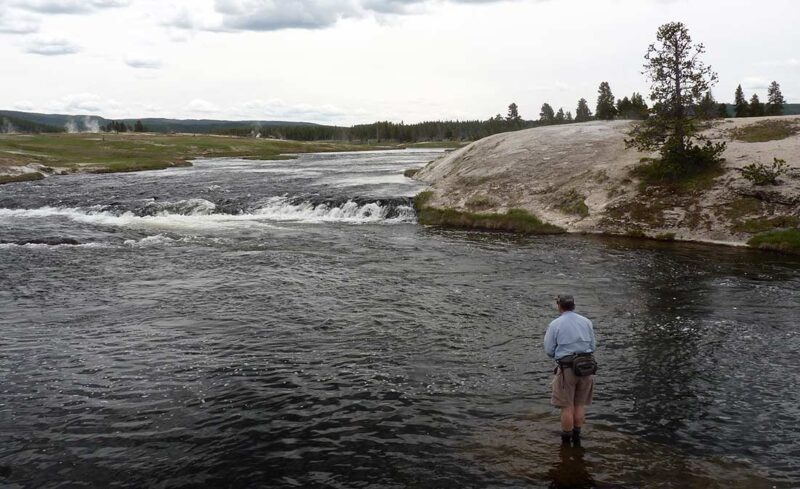
Typical structure in meadow sections of the Firehole and Madison: hot spring and hot spring deposit in background, and large pools separated by torrential “rapids” where the river is actually falling ankle-deep over lava and hot spring deposit shelves.
On the other hand, summer fishing in the Madison System in YNP is very limited. The upper Gibbon—really a small creek—remains cold and productive, as does the upper Firehole, which is not only a small creek but one populated only by hand-size brook trout. Otherwise, the mainstem streams in the Madison System all get too warm to fish productively or ethically from sometime in late June (drought years) or early July through sometime between August 25 and Labor Day. The tributaries discussed on the small streams page remain cold and can fish well, but they’re some combination of remote and difficult, since their lower reaches are populated primarily by large, spooky “refugee” fish, rather than the hand-size swarms more common in most area small streams.
This all adds up to make the Madison System very important to visiting anglers in June and October and often very crowded at these times, but not someplace most people will want to fish during the July through September peak tourism season.
- We run most of our Walk & Wade Guided Trips in the Madison System in June, particularly on the Gibbon River but also on the Firehole. We may also fish headwaters portions of the Gibbon during the high season, depending on client interests.
- Firehole River Streamflow Gauge: Avoid fishing after 2:00PM when water temps on this gauge exceed 73 degrees. Avoid fishing the Firehole downstream of Old Faithful at all if temperatures exceed 75 degrees or fail to get below 70 degrees. Note that this gauge is located downstream of all hot spring inflow, so portions of the Firehole closer to Old Faithful will be a couple degrees cooler.
- Gibbon River Streamflow Gauge: Look for dropping flows under 300cfs for the Gibbon Canyon and meadows to be fishable, more like 150cfs for areas above Norris Geyser Basin. Avoid fishing when water temps exceed 73 at this gauge.
- Madison River in YNP Streamflow Gauge: Look for flows no higher than 1000cfs and temps lower than 70 degrees on this gauge. Note that this gauge is near West Yellowstone far downstream from any hot water inputs, so water temperatures will run higher upstream near Madison Junction where the better June and early July fishing is found.
Madison River System in Yellowstone Park – Description
Besides the hot spring basins, which create surreal landscapes for fly fishing as well as some hazards (scalding being less likely than sudden drop-offs midstream where old hot spring vents reside, places deep enough to float your hat), the Madison basin is notable for two characters which offer very different fishing.
The first is a gentle riffle-pool character where the rivers snake through banks covered in a mix of grass and occasional woodland. The banks in these areas are undercut except where the the bottom is composed of geyser and lava deposit rather than silt and gravel. The faster areas are generally knee-deep and full of bugs, while the pools can be exceptionally deep, full of weeds, and slow-moving. On the Gibbon and Madison, these areas hold comparatively large, spooky trout. On the Madison and Gibbon downstream of Norris Geyser Basin, these are most likely browns in the 14–20″ class, while upstream of Norris Geyser Basin westslope cutthroats several inches shorter now dominate. There are big fish on the Firehole, too, but not many. Instead the gentle riffle-pool areas tend to hold very high numbers of mixed browns and rainbows which can often be just as spooky as the big browns, despite seldom exceeding 14 inches and often running much smaller.
The other character occurs where streams in this basin cut through lava rock canyons. These areas are swift and often shallow. Both the Firehole and Gibbon have numerous named and unnamed cascades, rapids, and waterfalls in such areas, which serve as fish barriers. The most important of these falls are Kepler Cascades, Firehole Cascade, and Firehole Falls on the Firehole and Gibbon Falls on the Gibbon. Kepler Cascades blocks upstream migration of brown and rainbow trout into the upper Firehole (upstream it’s all hand-size brookies), Firehole Cascade and Firehole Falls limits the fish populations of the upper Firehole Canyon since the fish in this stretch can’t escape the summer heat by running into tributaries, and Firehole and Gibbon Falls both block upstream migration of spawning trout from Hebgen Lake on the Madison.

Minus the waterfall (a small hot spring stream), this portion of the lower Gibbon River Canyon gives a good illustration of what canyon stretches of both the Firehole and Gibbon look like.
Otherwise, these areas offer a mixed bag as far as fishing. Where the bottom is composed of gravel, boulders, and cobble, good pocket water fishing for lots of 6–12″ resident trout is available, with opportunities for big browns and rainbows on their runs from Hebgen in the fall and to a lesser extent in early June when there are still a few winter holdovers which haven’t returned to the lake yet. The Gibbon River Canyon between Gibbon Meadows and National Park Meadow near the confluence with the Firehole is the best example of this type of water.
Where the bottom is solid lava rock interspersed with patches of gravel in the crevices, fishing is generally poor since there’s nowhere for insect prey to live on solid rock. The Firehole River a short distance upstream from the Firehole Canyon and much of the Madison’s lower portion in the park fit this mold.
In all areas of the Madison System except the headwaters of the Firehole and Gibbon, bison and elk herds are common. There are also lots of chances to see bears in areas away from the road, as well as plenty of off-road hot springs, small geysers, mud pots, etc.
Madison River System in YNP – Waters
Firehole River
The Firehole River has been called the “strangest trout river on Earth.” A drive along its most popular and productive section makes clear why. Something like half the world’s geyser basins feed into the Firehole. Their steam is what gave the river its name. This is the region’s top fishery from the opener in late May through mid-June. From July through the first serious cold snap in September, all but the Firehole’s headwaters (small brook trout) become too warm to fish. The river can exceed 80 degrees in late afternoon in spots during drought summers. The fishing turns on again after the first cold snap, peaking again in early October.
The Firehole begins at fishless Madison Lake near the Continental Divide. Down to Kepler Cascades, this is a fast riffle-pool mountain creek in the woods. It’s home to small brook trout and fishes best in midsummer. As such it won’t be of much interest to Gardiner-based anglers since similar fisheries are available much closer. From Kepler Cascades to the closure zone centered on Old Faithful which begins at the road bridge just south of Old Faithful, there’s a short and very rugged canyon that holds a mixed bag of browns, rainbows, and brook trout. Some of these fish can exceed 15 inches, but this is a very small piece of water only large enough for a half-day of fishing.
The “real” Firehole begins at the downstream end of the Old Faithful closure, at Biscuit Basin. Now a warm, weedy riffle-pool stream that’s difficult to impossible to wade across in most places until autumn, the Firehole is an insect factory full of fish. From here to the top of the Firehole Canyon at Firehole Cascades (about 20mi), anywhere that isn’t unavailable due to a herd of bison or a herd of other anglers and doesn’t have a solid lava rock bottom can fish very well. Swinging soft hackles is the most productive method. This imitates the caddisflies that dominate insect populations here. Three species of caddis are common: the olive Mother’s Day Caddis, the summer Tan Caddis, and especially the blond Nectopsyche or White Miller Caddis. This last insect is found in very limited numbers elsewhere but hatches in vast swarms on the Firehole from early June through mid-October, right through the hot summer months when this stretch of the Firehole is far too warm to fish. There are also BWO in late May, June, and October, and PMD in June, plus a smattering of damselflies and other insects.
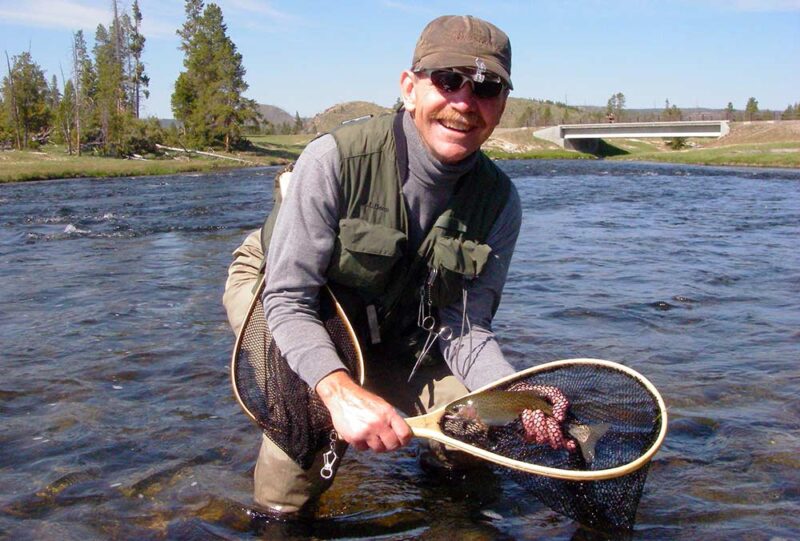
Typical structure and rainbow trout found on the Firehole River.
The Firehole Canyon is a tight canyon with near-vertical walls and bottomless pools. The upper canyon between Firehole Cascades and Firehole Falls is almost inaccessible except at the official swimming hole, but it’s not worth your time anyway as it usually holds only a few small trout. The lower canyon below Firehole Falls is less than a mile long but can be okay during the early June Salmonfly hatch and again in October when Madison-run fish can be nymphed up from the deepest slots.
The Firehole is home to few large trout, but vast swarms of fat, healthy smaller rainbows and browns. In an average day, you’re lucky to see fish larger than fourteen inches. That said, when hatches are underway (as they often are), it can seem like the entire stream is boiling with rising trout. The few larger fish that aren’t running in from Hebgen Lake via the Madison tend to live near cold tributary creeks, especially the Little Firehole near Biscuit Basin, where cold water refuges are available for the fish to migrate into to beat the summer heat.
Gibbon River
For such a short and small river (it’s less than 30 miles long and never too wide to cast across), the Gibbon has a remarkable number of characters. There are actually fewer of these characters than there used to be, since the fish populations of the upper river have been homogenized after an aggressive fisheries project in the past five years.
The Gibbon begins as the outlet of Grebe Lake. It then flows a couple miles into and out of Wolf Lake. From there it meanders through burned-over pine forests before jumping Little Gibbon Falls and entering Virginia Meadows. It winds across Virginia Meadows, then tumbles over Virginia Cascades into a short canyon and another run through pine forest before emerging into Norris Meadow near the Norris Campground. This entire upper run is small water averaging between ten and twenty feet wide. Except in the deepest pools, it’s easy to wade, though the going can be tough due to downed trees and steep canyon walls. There are a couple road crossings and the Virginia Cascades Drive briefly parallels the stream. Otherwise, this is hike-in water and the trail is often not near the stream.
This area used to hold a total mixed bag of fish, with rainbows and a few grayling at the top and in the headwaters lakes, brookies in the middle, and a mix of browns, brookies, rainbows, and a few grayling down low. After a fisheries project in recent years, the fish from the headwaters to Virginia Cascades are now westslope cutthroat and grayling. They’re nowhere near as abundant as old populations, but they get bigger. Instead of scads of finger-length brookies, there are 1/10 as many cutthroats and grayling that are spooky, average 12 inches, and can reach 16 inches. Huge improvement for most anglers, though not for the young kids I used to guide here. Downstream of Virginia Cascades, populations are still a mixed bag, though the cutthroat numbers are rising fast. All of this water fishes best from late June through mid-August.
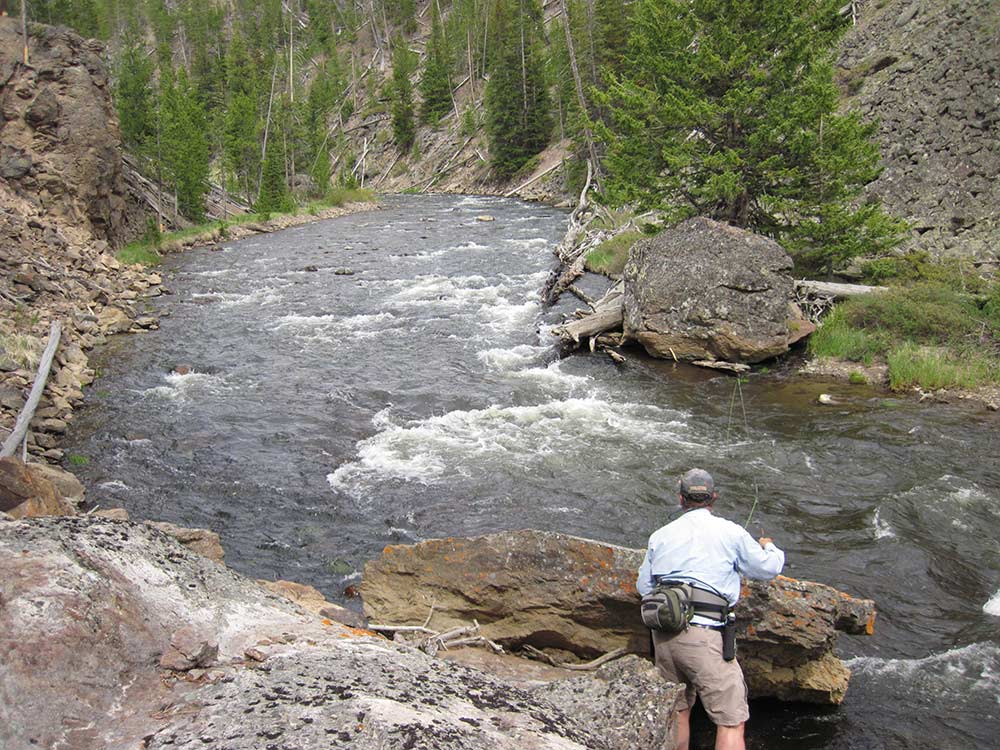
Upper GIbbon River Canyon
From Norris Meadow to Elk Park, the Gibbon flows behind Norris Geyser Basin. The geyser water enlarges, warms, and enriches the Gibbon. From here downstream, the Gibbon fishes best in June and maybe early July, then again in October. The June fishing is generally better. When it reappears next to the road at Elk Park, it’s a glassy-smooth meadow stream home almost exclusively to spooky brown trout which can exceed 20 inches. This is hands-and-knees spooky fish fishing. It’s much better when hatches are underway. PMD and various Green Drakes are possible in June, while in late June and early July Brown Drakes are possible. The short Gibbon River Rapids separates Elk Park from Gibbon Meadows. The rapids are almost entirely lava rock and thus aren’t worth your time. Gibbon Meadows is similar to Elk Park.
The Gibbon River Canyon begins at the bottom of Elk Park and runs most of the way to National Park Meadow, at the bottom of which the Firehole and Gibbon join to form the Madison. The upper canyon down to Gibbon Falls is home to browns averaging 6–12 inches and very rarely getting more than a couple inches larger. That said, there are good numbers of these fish and the pocket water nature of this chunk of water makes it fish well with attractor dry-dropper combos in early June. Since no other portion of the Madison System in YNP fishes well with this technique in June, this is an attractive fishery for fit anglers of intermediate or less skill. The lower canyon has rainbows in addition to browns and can fish similarly to the upper canyon in June, but it’s less consistent overall and sees more pressure. There’s a chance of larger fish that have overwintered after spawning. I’ve seen a few 18-inchers. That said, many of the fish out-migrate to Hebgen, so overall populations are lower.
National Park Meadow can turn out some hatches in June, but it’s mostly a fall fishery where streamers and big nymphs tempt the run-up browns and rainbows.
Madison River in YNP
The Madison in YNP is very different from the river downstream in Montana. Instead of a fast, shallow, rocky freestone river, in the park the best portions of the Madison are slow, weedy, and often quite deep. Wading across the river is impossible in June and often very difficult in the fall, and the river can be more than 75 yards wide in places.
Resident trout populations are composed of relatively low numbers of brown and rainbow trout (and whitefish) averaging about 14 inches. These fish are spooky. Except for some good streamer and nymph fishing in June, and a very brief Salmonfly hatch in the short, rocky area known as the Madison River Canyon (which doesn’t warrant the name compared to many other canyons in the region), the best fishing for resident trout is when hatches are underway. A variety of caddis, BWO, and PMD can all bring rises. Bring your A-game to match these hatches: fish exact imitations and long/light leaders. This is effectively spring creek-style fishing, and thus for advanced and expert anglers only.
The more notable fishing on this stretch occurs in the fall. “Fall” starts in late August if there’s a couple cold, rainy days, but the best fishing is in October. Large numbers of fall-run browns and some rainbows migrate through the Madison on their way to spawning grounds in the lower Firehole and Gibbon. The spawn mostly takes place here in November, after the fishing season. This is steelhead-style fishing with streamers, large wet flies, and stonefly and large attractor nymphs. I’m not kidding about the steelhead comparison: many anglers now use lightweight spey rods. Since these are the most numerous large trout that can be targeted in Yellowstone Park, fishing pressure is heavy. The Madison is the only fishery in the region that sees heavier pressure in October than it does sometime during high summer and early fall peak tourist season. Dawn and dusk see lower crowds, but it’s tough to completely shed them and still be fishing good runs that hold more than the occasional lucky runner brown.
The river can be roughly divided into three sections. The first runs from Madison Junction down about half a mile past the road bridge on the way to West Yellowstone. This is the slowest, weediest water and is home to the largest numbers of resident trout. Most pressure in June concentrates here, though pressure can be heavy in the fall as well. The second stretch is broad and shallow, and runs most of the way to West Yellowstone. This area has some riffles, but the river mostly flows over lava shelves and thus has very poor habitat. It’s mostly home to fingerlings that haven’t migrated out to Hebgen Lake yet. As such, it sees and deserves little fishing pressure. The third stretch, the fabled “Barns Pools” and “Beaver Meadows” begin just inside the park’s west boundary. Here the Madison cuts abruptly north and flows in a serious of serpentine bends and pools that flirt with the park boundary. Except for the Barns Pools themselves, it’s best to have both Montana and Yellowstone Park licenses. This stretch has very low resident trout populations, but each riffle serves as a roadblock for migrating trout coming in from Hebgen Lake. As such, this water sees intense angling pressure beginning with the first trickle of migrants in late August. This pressure only intensifies through the close of the park season at sunset on Halloween. Despite the pressure, this is probably your best place in Yellowstone Park for legitimate chances at brown trout exceeding 20 inches. The average is 16–22 inches, but fish pushing 10lbs are caught almost every year.
Madison River System in YNP – Directions & Access
Access to the portions of the Madison System of any real interest to anglers is generally easy.
On the Madison River, the West Entrance Road and a few obvious stub roads provide access almost the entire distance between Madison Junction and the West Entrance. Simply pick an unoccupied pullout. Near the West Entrance, an unsigned stub road heads north just east of the West Entrance Station. This road ends at Barns Pool #1, while another stub road leads to parking for Barns Pool #2. A flat angler trail follows the river north-northwest to the Baker’s Hole Campground on US-191 just north of West Yellowstone. Note that much of the water between the Barns Pools and Baker’s Hole (the “Beaver Meadows”) is actually in Montana, so it’s wise to have both licenses.
The upper Firehole River is accessible via the Lone Star Geyser Trail which heads adjacent to Kepler Cascades. This is one of the few trails in Yellowstone Park where it’s legal to ride bikes and the trail is flat and wide, so it’s possible to get a long way off-road with minimal effort. The short chunk of water between Kepler and the Old Faithful closure zone is accessible via a parking area adjacent to the bridge that begins the closure.
The main portion of the Firehole is accessible via the Madison Junction to Old Faithful Road. Only the section between Midway Geyser Basin and Fountain Flats is away from the main road. This section is accessible via the Fountain Flats Road, which is a paved road at its bottom end and a good gravel trail (also open to bikes) elsewhere. The sections away from the main road see somewhat lower pressure, but since no portion of this water is more than about 1.5mi from a road and the going is flat and easy, everywhere can be crowded.
The Firehole Canyon is accessible via the Firehole Canyon Drive or by walking down the south side of the Gibbon River from the Gibbon’s bridge near Madison Junction. This is most useful when the Firehole Canyon Drive is closed.
The Gibbon River is a bit harder to access.
Upper reaches are accessible via the Grebe Lake or Wolf Lake Trails. The headwaters of the Gibbon at the outlet of Grebe Lake are about 4mi off road, though this is a flat and easy hike. The better portions of the Gibbon’s headwaters are less than 2mi from the Canyon–Norris Road via the Wolf Lake Trail. The area between the Canyon–Norris Road Bridge and Virginia Cascades is roadside and sees much higher pressure than it’s worth. Virginia Cascades to Norris Meadow is in deep dark timber without trails, so it sees little pressure except immediately adjacent to the road bridge just east of Norris Junction.
The remainder of the Gibbon is accessible via the Norris Jct. to Madison Jct. Road. This area is of the most interest to Gardiner-based anglers. The upper end of Elk Park and the area immediately downstream of Norris Meadow behind Norris Geyser Basin requires a short hike along the stream, from the bottom or top respectively. There’s a two-mile chunk of water through the upper Gibbon River Canyon where the road is now on the opposite side of the first hill from the stream. The road used to follow the stream and is still obvious, even though the pavement was torn up and replanted with grass and small lodgepole pines. Just walk downstream from the last pullout before the road pulls away or the first pullout where it returns, just above Gibbon Falls. The middle of this roadless section fishes very well, particularly when the stream is still too deep to ford near the upstream end, where the old road crossed via bridge and a stream crossing is required to head either direction. The remainder of the Gibbon is accessible via the road, though it’s often down a steep hill covered in downed timber. Pick any unoccupied pullout where you think you can manage the climb.
Angling
Fish Populations
- Rainbow Trout: Rainbows are the most common trout in the Madison System in YNP overall. They are found in the Firehole River downstream from Kepler Cascades, in the entire Madison River, and from Virginia Cascades to Norris Geyser Basin and downstream of Gibbon Falls on the Gibbon River. They are the dominant trout on the Firehole, but slightly less common than other species elsewhere. The average rainbows run 6–14 inches except in the fall, when fish averaging 14–20 inches run upstream from Hebgen Lake.
- Brown Trout: Browns are almost as common as rainbows and get bigger. They are found in the Firehole River downstream from Kepler Cascades, in the entire Madison River, and from Virginia Cascades downstream on the Gibbon River. They are the dominant species overall in the Gibbon River downstream from Kepler Cascades. Resident browns average 6–14 inches most places, but they run bigger on average in the meadows on the Gibbon River and larger fish are common in meadow water throughout the Madison System. The fall run of browns upstream into the Madison and lower portions of the Gibbon and Firehole from Hebgen Lake is world famous. These fish average 16–22 inches, but exceptional fish to 30 inches are caught almost every year.
- Westslope Cutthroat Trout: Recent recovery efforts have replaced the stunted brook trout from large portions of the upper Gibbon River including its headwaters lakes with westslope cutthroat native to the basin, if not the specific river section in question. These westslopes average 6–10 inches. There are also a few westslopes in Firehole tributaries, though they may not make it to the main river.
- Arctic Grayling: Grayling are scattered through the upper Gibbon River. Their numbers are much higher in the headwaters lakes. In the river (really small stream, where they live), they average 6–10 inches.
- Brook Trout: Brook trout are found in the Firehole River upstream from Old Faithful and in the Gibbon River between Virginia Cascades and Norris Geyser Basin, and in low numbers downstream. They used to dominate the upper Gibbon River while seldom getting longer than your hand and averaging finger-length. Their replacement by cutthroats is a major improvement. Brookies are also found in almost all tributary creeks in the system.
- Mountain Whitefish: are found in sparse numbers downstream from Gibbon Falls and Firehole Falls. They average 12 inches but can exceed 20 inches.
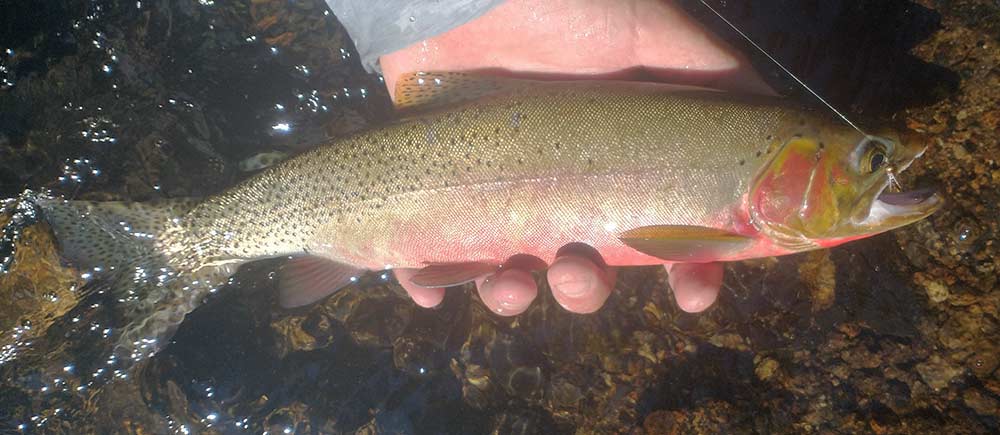
Medium-sized westslope cutthroat trout have replaced finger-length brook trout in much of the upper Gibbon River.
Madison River System in YNP Fishing Season – When It’s Open & When It’s Good
The entire Madison System in YNP opens with the general season on the Saturday of Memorial Day Weekend. Unlike most waters in Yellowstone Park, some portion of the Madison System is almost always fishable on the opener. In average or wet years, the Firehole River (particularly between Biscuit Basin and Midway Geyser Basin is the only game in town, while in dry years the entire basin downstream of its major hot spring basins (Old Faithful on the Firehole and Norris on the Gibbon) is ready on the opener. Even in wet years, the entire basin downstream of the hot springs drops into good shape by June 10. The best fishing in this area is in June. Good fishing on the Firehole and Madison is also possible in September and October. The Madison in particular is the most popular late October fishery in the region, due to its intense brown trout spawning runs up from Hebgen Lake. The lower Gibbon River is also fishable from Labor Day through October, but it’s not as good a this time as it is in June.
The Firehole River upstream from Old Faithful drops into shape in mid-June, with the best fishing in late June and July. The upper Gibbon River comes into shape between June 10 (dry years) and July 1 (wet, cold years). It fishes best in July and August. The Madison River and portions of the Firehole and Gibbon downstream of their major hot springs are far too warm in midsummer. The Firehole in particular can reach 80 degrees in late July; it’s almost always a terrible fishery from sometime between June 20 and July 1 and Labor Day. The Madison and Lower Gibbon hang on a week or two longer, but they’re likewise terrible bets in late July and August, since they get far too warm for trout to feed well at best and survive angling pressure at worst.
Madison River System in YNP Fishing Tactics
For most of the season, the primary guideline in choosing tactics is whether you’re fishing rough water or mellow water. In rough water, attractor dry-dropper combos work best. In the Gibbon Canyon, these combos can be relatively large, especially when any stoneflies are hatching. Think a #10 Chubby Chernobyl with a large beadhead Prince underneath. More often than not, somewhat smaller attractors like #12 Trudes are better bets even in the Gibbon Canyon, and certainly in the upper Firehole where the trout are almost all small. The upper Gibbon River likewise fishes better with #12–18 attractor flies (Hazy Cripples, small Wulffs, Trudes, etc. on top, with tiny Princes, flashback Pheasant Tails, and the like underneath) than it does with larger flies.
In flatter water, imitating specific insects is usually the best tactic. If there’s no hatch, the fishing can be very hard. This is especially true on the Madison River and in the Gibbon’s meadow sections. In these areas, it may seem like there aren’t any fish at all when no hatch is underway. Even if there is a hatch, the fish are often very particular. You need to obtain good drifts with light tippets, and may need to fish emergers, cripples, and so on rather than easier-to-see patterns.
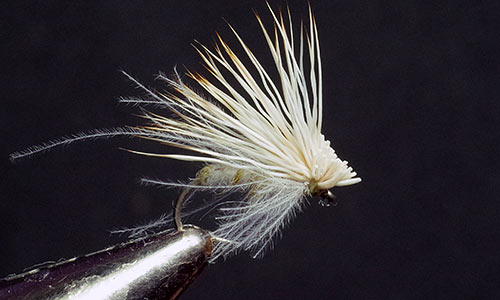
White Miller Caddis imitation
The Firehole is usually more forgiving than the Madison or meadow stretches of the Gibbon. since the Firehole has more fishable riffles and deep lava rock ledges. In the riffles, swing soft hackles if there’s no hatch (and even if there is one). On sunny days in particular it’s often more effective to nymph the deepest rock ledges. This is especially true in late June and in the fall, when the riffles are shallower and more exposed. That said, the best fishing on the Firehole is unquestionably when hatches are underway. The White Miller hatch almost always gets the trout excited. Very large numbers of hand-size fish usually feed in the riffles when this hatch is underway, but smaller numbers of somewhat bigger (and spookier) fish are found in the pools. The other marquee hatch on the Firehole is the fall Blue-winged Olive. These insects are often tiny, size-22 or so, whereas in late May they are a more manageable #18.
The main exception to hatch-matching in meadow areas is early in the season, no more than the first two weeks of the season on the Firehole and prior to June 20 even in wet years elsewhere. At these times, medium sized Woolly Buggers are worth stripping under the undercut banks.
Things change on the Madison and lower Gibbon and Firehole in the fall. The run-up fish do not really feed, but they are territorial and prone to striking out of aggression. As such, larger and flashier flies are required except during hatches (when hatch-matching is still a better idea). Most fish are caught in the prominent runs and pools on stonefly and large attractor nymphs like Girdle Bugs trailing attractors ranging from San Juan Worms to egg patterns to Bead, Hare, and Coppers. A more-traditional but somewhat less effective technique is to swing medium-sized streamers (Zonkers, Woolly Buggers, etc.) or steelhead-style soft hackles and wet flies. Many of the latter have been designed by fly tiers out of Blue Ribbon Flies in West Yellowstone specifically for this fishery. This fishing is almost always better in the couple hours after dawn and the hour before dusk, which makes for early starts or late finishes if you’re based in Gardiner.
Insect Hatches & Other Prey
Insect hatches are of critical importance to the angler on the gentle sections of the Firehole and Gibbon, on the Madison in June and to a lesser extent in fall, and can be important even in canyon sections of the Firehole and Gibbon. That said, rough water areas usually fish better with attractor patterns.
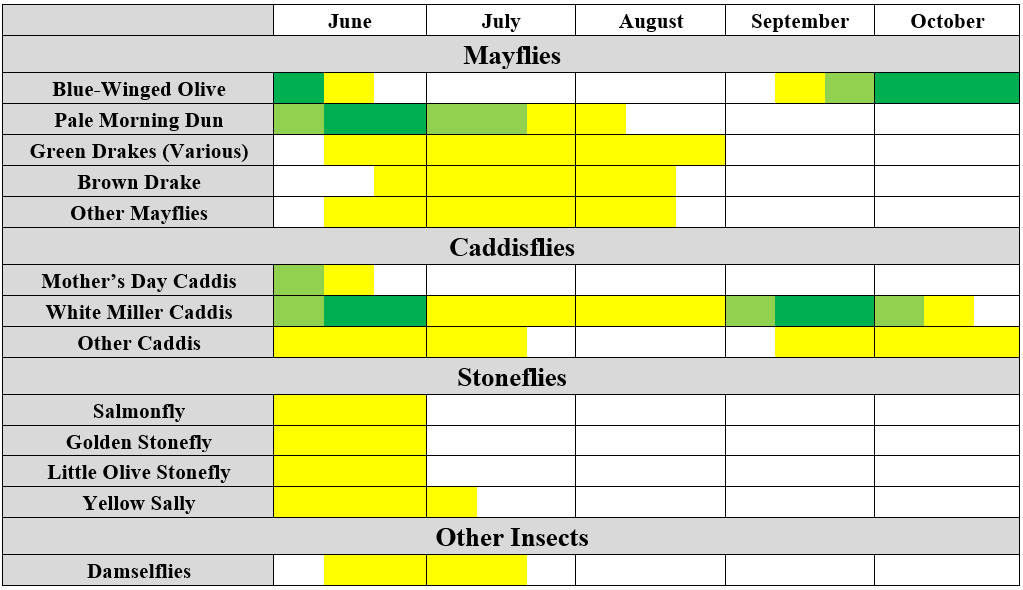
Other prey types and patterns vary in importance depending on the water. Attractor flies of all sorts are most important in the headwaters of the Firehole and in the Gibbon River Canyon, while smaller attractors work well in the upper Gibbon and occasionally on the Firehole in early June. Soft hackles are of greatest importance on the Firehole, but they can work well on the Madison at times as well. Very large steelhead-style wet flies like the Shakey Beeley are important on the Madison in the fall. Streamers work best when the water is high and a bit murky in early June and again late in the season for run-up fish.
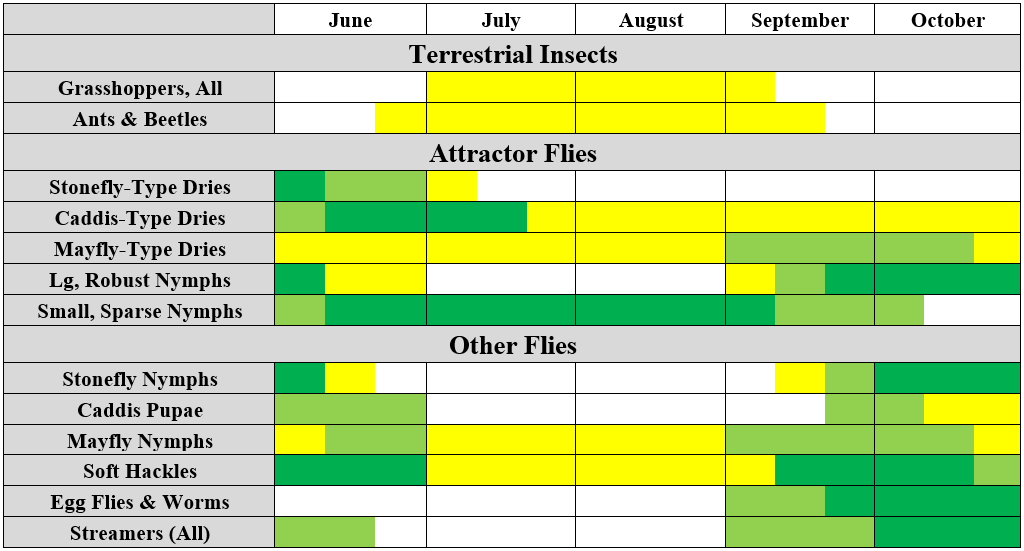
Top 10 Flies for the Madison System in YNP
- Glasshead Soft Hackle Pheasant Tail, #16
- Beadhead Prince, #16
- Coachman Trude, #12
- Purple Hazy Cripple, #16
- White Miller Soft Hackle, #14
- Bead, Hare, and Copper, #12
- PMD Sparkle Dun, #16–18
- Tan/Black Girdle Bug, #6
- Tunghead 20-Incher, #10
- Shakey Beeley, #10
The list is a bit misleading. The soft hackles are always good bets, particularly on the Firehole, and medium-sized attractor dry flies are usually the most important flies in the Gibbon River Canyon and on the upper Firehole. Big nasty flies like Girdle Bugs and so on generally only work in the fall, for run-up trout from Hebgen Lake.
Otherwise, your greatest success will be in matching specific insect hatches with dedicated hatch-matching flies. The PMD Sparkle Dun is a starting point for Pale Morning Duns, but otherwise you may need to get a bit fancy and expect to change flies often.